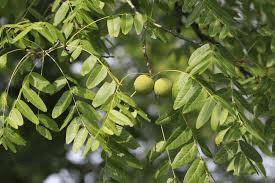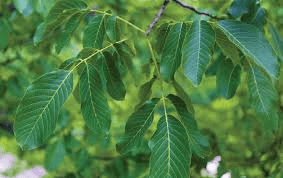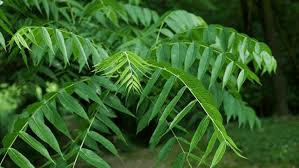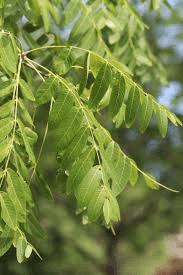Walnut leaves, specifically from the Juglans genus, are an interesting subject in botany due to their unique properties and various uses. These leaves are pinnately compound, which means they are composed of multiple leaflets arranged on either side of a common axis. Typically, a walnut leaf consists of 5 to 9 leaflets, though the number can vary depending on the species and environmental conditions.
The leaflets of walnut leaves are oblong to ovate in shape, with serrated margins, and they range in size from 6 to 15 centimeters in length. The upper surface of the leaflets is usually a dark green, glossy, and smooth, while the underside is lighter in color and may have a slightly hairy texture. The leaves are arranged alternately on the branches and give off a distinctive aroma when crushed, often described as a spicy or pungent scent.
One of the most notable aspects of walnut leaves is their chemical composition. They contain several bioactive compounds, including juglone (5-hydroxy-1,4-naphthoquinone), tannins, flavonoids, and essential oils. Juglone is particularly significant because it has allelopathic properties, meaning it can inhibit the growth of surrounding plants.
This chemical is primarily found in the leaves, roots, and fruit husks of walnut trees and can affect the biodiversity of the area around the tree, as it prevents the growth of many other plant species.
Walnut leaves have been utilized in traditional medicine for centuries. They are known for their anti-inflammatory, astringent, and antimicrobial properties. In various cultures, extracts from walnut leaves have been used to treat skin conditions such as eczema and acne, as well as to promote wound healing. Additionally, these leaves have been used to make infusions and decoctions for internal use, believed to aid in digestive issues and to act as a general tonic for the body.
In modern scientific research, the potential health benefits of walnut leaves continue to be explored. Studies have shown that extracts from these leaves exhibit significant antioxidant activity, which can help in protecting cells from oxidative stress and reduce the risk of chronic diseases. Moreover, the antimicrobial properties of walnut leaf extracts have been demonstrated against a range of pathogens, including bacteria and fungi, making them a promising natural remedy for infections.
The ecological role of walnut leaves is also noteworthy. As they decompose, they enrich the soil with organic matter and nutrients. However, the presence of juglone means that they need to be composted carefully. Gardeners often avoid using fresh walnut leaves as mulch or compost due to the risk of inhibiting plant growth, but well-composted walnut leaves are generally considered safe and beneficial for soil health.
In agriculture, walnut leaves can play a role in pest management. The compounds in the leaves can deter certain insects and pests, reducing the need for chemical pesticides. This makes walnut trees valuable in integrated pest management strategies aimed at sustainable and environmentally friendly farming practices.
Despite their benefits, walnut leaves can pose challenges for certain crops due to their allelopathic effects. Careful management and understanding of these properties are essential for farmers and gardeners who have walnut trees on their land. By harnessing the positive aspects of walnut leaves while mitigating their inhibitory effects, it is possible to maintain a balanced and productive ecosystem.
The Economic Importance and Uses of Walnut Leaves

1. Traditional Medicine: Walnut leaves are used in traditional remedies for treating skin conditions, inflammation, and digestive issues.
2. Herbal Teas: Walnut leaves are dried and used to make herbal teas that are believed to have various health benefits.
3. Natural Pesticide: Compounds in walnut leaves can act as natural pesticides, repelling insects and pests from crops.
4. Animal Feed: Walnut leaves are sometimes used as a supplementary feed for livestock due to their nutritional content.
5. Mulch: Walnut leaves are used as mulch in gardens to suppress weeds and retain soil moisture.
6. Composting: Walnut leaves can be composted to create nutrient-rich compost for improving soil health.
7. Dye Production: Walnut leaves are used to produce natural dyes for textiles, providing green and yellow hues.
8. Aromatherapy: The essential oils extracted from walnut leaves are used in aromatherapy for their soothing and therapeutic properties.
9. Cosmetic Industry: Extracts from walnut leaves are used in skincare products for their anti-inflammatory and antioxidant properties.
10. Soil Amendment: Walnut leaves are used as a soil amendment to improve soil structure and fertility.
11. Veterinary Medicine: Walnut leaves are used in some traditional veterinary remedies to treat livestock ailments.
12. Natural Fertilizer: Walnut leaves can be used to create a natural fertilizer, enriching the soil with organic matter.
13. Craft and Decoration: Walnut leaves are used in crafts and decorations for their aesthetic appeal.
14. Research and Development: Walnut leaves are studied for their potential health benefits and applications in various industries.
15. Insect Repellent: Walnut leaves can be used to make natural insect repellent sprays.
16. Bedding for Livestock: Dried walnut leaves are used as bedding material for livestock, providing a soft and absorbent surface.
17. Bioactive Compounds: Walnut leaves are a source of bioactive compounds used in the pharmaceutical and nutraceutical industries.
18. Erosion Control: Walnut leaves are used in erosion control measures to stabilize soil and prevent erosion.
Read Also: Health Benefits and Side Effects of Opium Poppy (Papaver Somniferum)
The Products and By-products That Can Be Derived From Walnut Leaves

1. Herbal Teas: Dried walnut leaves are used to make herbal teas.
2. Natural Dyes: Walnut leaves processed to produce natural green and yellow dyes for textiles.
3. Natural Pesticides: Walnut leaves used to create pesticide sprays to repel insects and pests.
4. Animal Feed Supplement: Walnut leaves used as a supplementary feed for livestock.
5. Mulch: Walnut leaves applied as mulch in gardens for weed suppression and moisture retention.
6. Compost: Walnut leaves composted to create nutrient-rich compost for soil enrichment.
7. Essential Oils: Extracted from walnut leaves for use in aromatherapy and cosmetics.
8. Skincare Products: Walnut leaf extracts used in creams, lotions, and anti-inflammatory products.
9. Soil Amendments: Walnut leaves used to improve soil structure and fertility.
10. Veterinary Remedies: Traditional veterinary remedies made from walnut leaves.
11. Natural Fertilizers: Walnut leaves processed into natural fertilizers for organic farming.
12. Craft Materials: Walnut leaves used in craft projects and decorative items.
13. Research Materials: Walnut leaves studied for new industrial and pharmaceutical applications.
14. Insect Repellent Sprays: Walnut leaves used to make natural insect repellent sprays.
15. Livestock Bedding: Dried walnut leaves used as bedding material for livestock.
16. Bioactive Extracts: Walnut leaf extracts used in pharmaceutical and nutraceutical products.
17. Erosion Control Products: Walnut leaves used in products to stabilize soil and prevent erosion.
18. Aromatherapy Products: Walnut leaf essential oils used in aromatherapy blends.
Read Also: 10 Medicinal Health Benefits of Erianthemum dregei (Wild Pomegranate)
Frequently Asked Questions (FAQ’s) About Walnut Leaves

1. What are walnut leaves? Walnut leaves are the foliage of the walnut tree, known for their medicinal and practical uses.
2. How are walnut leaves used in traditional medicine? Walnut leaves are used in traditional remedies to treat skin conditions, inflammation, and digestive issues.
3. Can walnut leaves be used to make tea? Yes, dried walnut leaves are used to make herbal teas with various health benefits.
4. What are the pest-repelling properties of walnut leaves? Compounds in walnut leaves act as natural pesticides, repelling insects and pests from crops.
5. How are walnut leaves used in animal feed? Walnut leaves are sometimes used as a supplementary feed for livestock due to their nutritional content.
6. Can walnut leaves be used as mulch? Yes, walnut leaves are used as mulch in gardens to suppress weeds and retain soil moisture.
7. Are walnut leaves beneficial for composting? Yes, walnut leaves can be composted to create nutrient-rich compost for improving soil health.
8. How are walnut leaves used in dye production? Walnut leaves are processed to produce natural dyes for textiles, providing green and yellow hues.
9. What is the role of walnut leaves in aromatherapy? Essential oils extracted from walnut leaves are used in aromatherapy for their soothing and therapeutic properties.
10. How are walnut leaves used in the cosmetic industry? Extracts from walnut leaves are used in skincare products for their anti-inflammatory and antioxidant properties.

